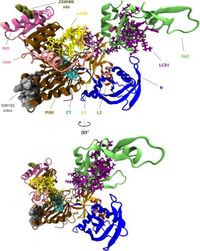Human Argonaute proteins, essential players in RNA interference, have shown considerable potential in understanding gene regulation. Four human Argonaute (AGO) proteins, although structurally similar, exhibit distinct functional attributes in their mechanisms of action. Recent research employed microsecond-scale molecular dynamics simulations to investigate these proteins' dynamic conformational landscapes, revealing unique interdomain interactions and conformational states.
Conducted by a team of researchers led by an international consortium, this study seeks to deepen our understanding of the Argonaute family, which includes AGO1, AGO2, AGO3, and AGO4, and their implications in post-transcriptional gene regulation and cellular processes.
Published on March 20, 2025, the research provides insights into the differences in structural behavior among these proteins, suggesting that while they share common origins, their regulatory functions might diverge significantly.
The importance of this study lies in how it addresses fundamental biological questions regarding the RNA interference pathway, which is crucial for maintaining gene expression and, consequently, cellular homeostasis. The primary objective was to decipher how structural variations contribute to functional disparities among the AGOs.
Each of the four AGO proteins possesses an extensive domain structure, characterized by an N-terminal domain, a PAZ domain, a MID domain, and a PIWI domain. Despite their shared framework, this new study has identified significant disparities in how each protein interacts with small RNAs, specifically microRNAs (miRNAs). These molecules play a pivotal role in gene silencing by targeting specific messenger RNAs (mRNAs) for degradation or translational inhibition.
The research team executed three independent microsecond-scale simulations to explore these proteins' free states, focusing particularly on their unbound conformations. They discovered that AGO proteins could exhibit considerable variability in their structural dynamics, prompting the need for a re-evaluation of how these proteins are perceived in the context of cellular function.
Among several notable findings, the simulations indicated that AGO3 displayed the most mobility, while AGO4 emerged as the least flexible. Such differences could imply distinct roles for these proteins in vivo, particularly in terms of miRNA loading and processing efficiency. It was found that AGO1 and AGO4 had similar compaction levels, while AGO3 and AGO2 presented a less compact structure.
In terms of interactions, minimal differences were observed in the catalytic and pseudo-catalytic tetrads within the AGOs. This points towards a conserved mechanism across the Argonaute family, despite the individual proteins' unique functions. The catalytic tetrads in AGO2 and AGO3 facilitate RNA slicing, a function not present in AGO1 and AGO4, which may indicate specialization among them in processing distinct classes of small RNAs.
Furthermore, the study revealed potential binding and interaction sites for each AGO protein, indicating how these proteins relate to zinc ions, which are crucial for the stability and functionality of various proteins within the cell. The significance of these findings expands our perspective on AGO proteins and suggests connections to processes like mitosis, where zinc ions have been implicated in regulatory roles.
Insights from this study could pave the way for more refined experimental approaches, especially in drug design and targeted gene therapy applications. As AGOs play a crucial role in several cellular processes, understanding their detailed structural dynamics may help devise strategies to harness or modulate their functions for therapeutic benefits.
As this research pushes boundaries, it not only highlights the intricate workings of the Argonaute family but also encourages further exploration into the roles these proteins play beyond RNA interference—a step forward in gene regulation and its implications in health and disease.




